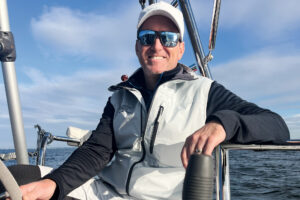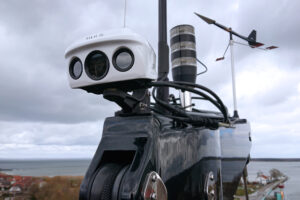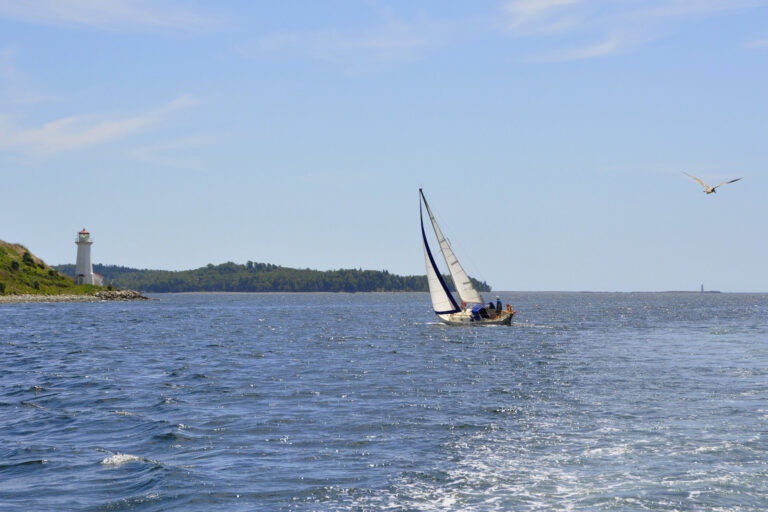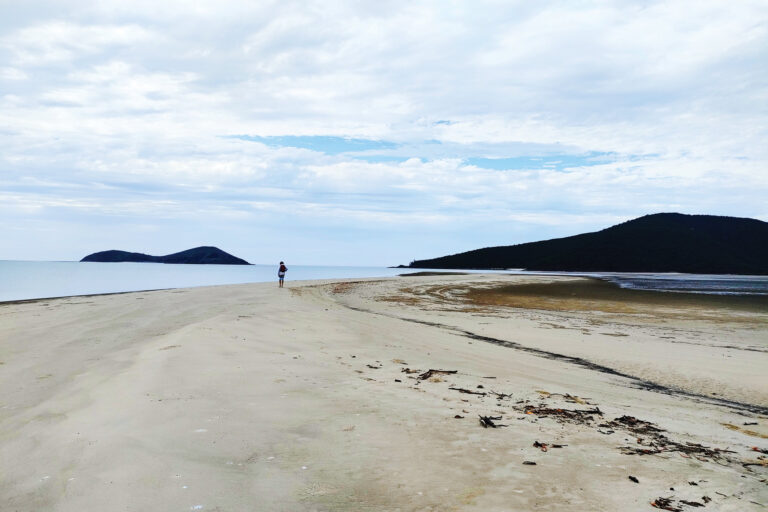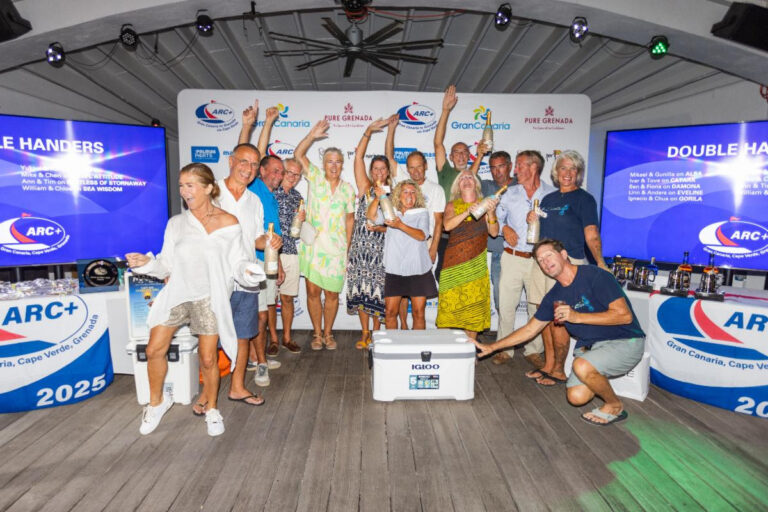
Ganesh’s New Engine
I was thinking heavy philosophical thoughts, as I often do during moments of great misery. Actually, that’s too mild of a description; I don’t want to pull punches. What I was experiencing was complete agony, awful suffering, total woe. We were repowering. I was grinding sharp shards of fiberglass within the tiny enclosed engine room of our 43-foot Wauquiez ketch, Ganesh. In the tropics. At midday. I was dressed in a full zoot suit, complete with gloves, respirator, and fogged goggles. To prevent the itchy glass dust from getting everywhere in our floating home, my wife, Carolyn, had sealed me off inside with plastic sheeting. I was pouring sweat. I could feel a thick crust of toxic dust forming around my damp nostrils despite my expensive breathing mask. There was barely room in the tiny space for me and my grinder. Often, I’d lose sight in the murk of my grinding disc, spinning murderously at 8,000 rpm. I was worried about my feet. Crocs aren’t the perfect footwear for such endeavors. I could barely turn around. It was claustrophobic. I itched. I wanted to scratch. My back hurt. My left calf was cramping up. Even worse, I was sitting uncomfortably on an improvised seat of sticks between my newly made engine beds. I didn’t want to grind off a toe or two by mistake. Thus, I concentrated fully on the task at hand—and pondered the Sailing Life’s big question: Why do they call it pleasure boating?
Yes, things can always get worse. I heard a loud crack! Suddenly I was falling backward. I knew what was coming.
I concentrated grimly on controlling the spinning grinder as I fell backward, my cringing butt cheeks tingling with dreaded anticipation. I’d been grinding with one hand. The trigger was locked on. The heavy, powerful grinder roared.
I desperately didn’t want the dust to suddenly run red. Gravity can be cruel. The sharp fiberglass shards didn’t flinch. I screamed as they pierced my buttocks in a thousand flares of raw pain.
The philosophical revelation came to me as clear and defined as a bolt of summer lightning: The reason I was able to sail around the world on pennies was because I was willing to pay for my ticket in blood, sweat, and tears.
Everything in life has a price, but the coin of the realm can vary. I seldom worked ashore, and thus I was poor. But I was strong, and I was determined to transform a dock queen named Papybus into an ocean greyhound named Ganesh. I didn’t want just a sailboat; I wanted a fully capable oceangoing cruiser. Not many modern vessels fall into this category. But this ol’ girl would, and would soon. So I ground and ground until I heard my concerned wife outside pleading with me to take a break.
I knew before buying Ganesh that she’d need to be repowered; that was one of the reasons her price was right. The only questions were when and how? I decided I didn’t want to be unexpectedly forced to repower far off the beaten track, away from friends and the tech benefits of the industrialized world.
First I needed to decide which engine to buy. I was taking out a 32-year-old Perkins 4-154 that was still running, though barely. I decided on another Perkins, the M92B. About the same weight and size, it offered similar fuel economy but was about a third again more powerful, with tons of low-end torque.
And while I wanted a boat that could sail in light airs and close quarters, it had to be a bit of a tugboat at the same time.
Also a factor: Time marches on, and I’m not getting any younger. Every decision I make today, I’m making for the 70-year-old sailor that’ll be me in 10 short years. And I plan to circumnavigate another time or two.
The second question was when and where to repower? I decided I needed a country that was yacht friendly and had a wide array of marine services: machine shop, electrical supply, and the like. Plus I needed to borrow some expertise, if not labor. I’m not a marine engineer, merely a lowly scribe.
So I happily cozied up to Tom Gerker and Diesel Dan Durban of Parts and Power in Tortola, in the lovely British Virgin Islands. I’d do most of the grunt work, and they’d do all the engineering.
The eastern Caribbean is my hood, so to speak. Its hardworking, knowledgeable marine employees are my peeps. When I needed my too-stuck prop flange coaxed off (with a prayer and a sledge), I turned to Sebastian John. Ditto Sanchez Christopher when I needed help with my engine alignment; Nigel Palmer when I had hydraulic oil spraying the engine room; and Tony Tuckett when I needed a JCB forklift to tote “dis and dat, me son.”
Each of these West Indian men aren’t just super marine mechanics; they’re wonderful people as well. And when I needed to remove the old Perkins and swing the new one aboard, Clarence Malone of The Moorings allowed me to use its dock crane gratis for a “few moments over lunch.” The dockmaster at Village Cay, a local fellow named James Hart, who everyone calls Pumpkin, allowed me to tie up in Slip C7. Ditto, BVI Yacht Charters, which allowed me to remove my hard dodger and swing off my cockpit-floor with the steering pedestal and table attached.
Yeah, it takes a village.
The point I’m try to make is that we’re all sailors here in the Lesser Antilles, willing and ready to help each other escape to sea while we’re shaking the money tree to finance our own cruises. Every sailor that sails off marks a collective victory for all.
Of course, such a large, multistep project seldom goes smoothly. A few surprises always pop up along the way.
Example: While Ganesh’s new engine is about the same size as the old, its ZF 45-1 transmission is larger, to handle the additional horsepower. Thus, my engine beds had to be modified and dropped two inches to accommodate it.
Carolyn and I required 18 full 12-hour days to accomplish this with four gallons of West System epoxy, eight yards of biaxial cloth, and two yards of Fabmat cloth. Whew!
Scheduling was a problem. I only wanted to impose on The Moorings once, so I decided to lift off the old engine and swing aboard the new one at the same time. This required the new engine to live under a tarp suspended above the floorless cockpit and directly above the engine room for almost a month. Frankly, I didn’t enjoy working directly under it. All that stored kinetic energy directly above my head seemed like a Sword of Damocles waiting to strike.
Carolyn helped me every step of the way. She often destructed while I constructed. But she’d had a troublesome time removing the ancient stainless-steel muffler because its hoses had melted on through the years.
“Cut ’em!” I snarled, buried in the engine room. She did so. The clunky muffler was heavy, but she managed to drag it out of the engine room, up the companionway ladder, and across the floorless cockpit. Then fate stepped in. The hose, the very same hose that refused to budge for so long, unexpectedly released, precisely at the wrong time.
Suddenly, the boat shook. I heard a loud noise as something heavy smashed down. I panicked. Carolyn screamed. I could sense something heavy and metal and hurt-some descending upon me. It was an awful feeling.
Perspective is a funny thing, eh? Normally, I’d have been furious at Carolyn for dropping a heavy metal object on me, but because it was merely a 50-pound muffler and not a 1,000-pound engine, I was almost happy to be clobbered. “Hey, no problem!” I cried in joy. “Dis no big ting, Carolyn. I’s tough stuff. No worries, me darlin’!”
The larger tranny we installed required a larger prop-shaft flange. This required airfreighting in a new blank and having it machined by Nautool of Road Town, which also machined my engine-mount pads and keyways.
The slow-turning four-liter Perkins requires a three-inch exhaust system. Since I enjoy sailing in heavy weather and often heave to for long stretches of time, we decided to add a Centek water separator as insurance against water backing up through the exhaust.
Of course, while the engine was out, we replaced all our hoses, bilge pumps, and engine-room electronics as well as the engine instruments and alarms. All of this took seven weeks of intense labor. We did our own work and saved $20,000 over what it cost to do the job six months earlier on a similar boat. Was it easy? No. Was it fun? Sometimes. Did we learn something? Yes, a lot.
Finally, the big day arrived. Carolyn and I showered and put on fresh clothes and bandages. We were delighted to finally be free of fiberglass and grease for the first time in weeks. I hit the starter button. The Perkins roared to life. We both grinned ear to ear.
“Sounds perfect!” Carolyn said to me in her normal tone of voice—the engine was so quiet at idle that we could barely hear it purring beneath us.
But I didn’t reply. I was lost in philosophical thought once again. It dawned on me that, up until now, I’d never really, truly felt that I deserved to own such a well-constructed, plush yacht as Ganesh. Now I did. We’d paid our way—and paid in full.
“Good-bye, Babylon,” I whispered as Carolyn cast off the dock lines and I slid the eager Ganesh into forward gear and pointed her toward a distant horizon.
With work on Ganesh all but complete, Cap’n Fatty and Carolyn Goodlander are plotting waypoints west and contemplating their next transit of the Panama Canal.
How’s your engine running? The color of your diesel’s exhaust smoke can tell a tale. Click here to learn more.

